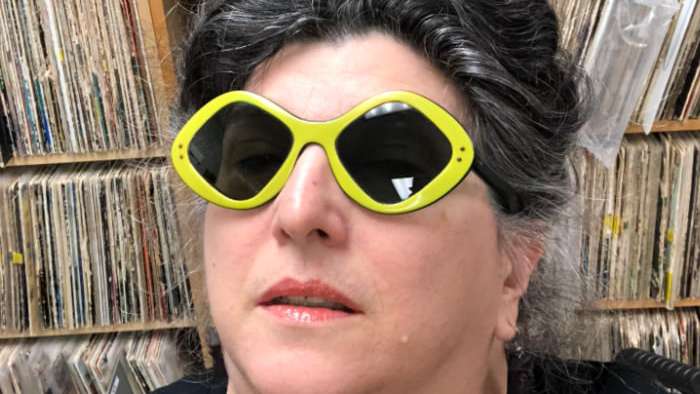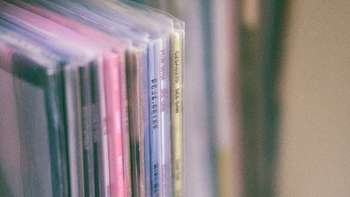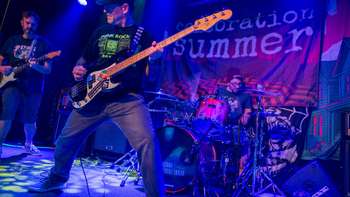
Scene Point Blank: Growing up, were there any specific radio DJs you regularly listened to who first got you interested in radio?
Stella: Well, my dad transferred his entire record collection onto reel-to-reel tapes because he didn't want to move his collection before leaving Cleveland. I still have the reel-to-reel recorder he'd listen to all these reels on. It's got this great little microphone and a nipper on the emblem in the back of the microphone. After each record, he would voice over who the artist was in his Italian accent. I'm very auditory by nature, so hearing those reels early in my life helped develop that part of me over time.
As for radio, KROQ used to have an AM station on the 1500 dial, so they had both an AM and FM station. So, in my 1965 Chevy Bel Air, I'd listen to the AM station, and before Rick Carroll took over KROQ's programming, the station had a lot of free-form radio. DJs like Jimmy Rabbitt were great -- the stuff he played was pretty funny. In fact, on that car radio, the speakers cracked to the Ramones’ "Let's Dance," but that was fine because it enhanced Dee Dee's bass. Back then, you could hear some wild stuff on AM, and getting an FM signal meant installing an additional radio outside your car's stock radio. Now with electric vehicles available, some big car manufacturers want to eliminate AM radios because the electric engines interfere with AM radio frequencies. A movement is happening to stop this that's already gotten Congress involved. There's a thing where you can text your congressmen to pass legislation ensuring car manufacturers don't get rid of AM radio. It's a safety thing. AM has the Emergency Alert System, which used to be called the Emergency Broadcast System, the EBS test for testing out equipment for various emergencies. At KXLU, KFI 640 AM is what we're tied into for that. So, if there's an emergency, if you start hearing codes, there's a whole procedure for this stuff. There's a binder at the station, you look in there, and there are instructions for what these codes mean. There's a sealed envelope with a list of these code interpretations. You'd open this envelope to hear what EBS is broadcasting and find out if someone's dropping a bomb. This originates from the Cold War times, the 1950s duck and cover era. If some emergency happens, you can tune into AM radio and get information on what is happening and what you can do. A good example of this is when you're watching a TV station, and a government message interrupts your show saying, "We're just conducting a test." That could happen in an emergency: the Emergency Alert System would take over KXLU and interrupt our signal. I haven't had my signal interrupted in a long time. But when one of these tests comes through Stray Pop, this device near the board starts spitting out paper like a cash register, carrying all the information related to the emergency test. That cracks me up still, I’d have to log in to the transmitter and note the test, then staple that paper to the daily log. [Laughs.
Scene Point Blank: Did the decision to attend Loyola Marymount University stem from the Catholic education angle since you attended St. Mary’s High School in Inglewood?
Stella: There are two reasons behind that decision. LMU's campus was close to my parent's house, and they wouldn't allow me to live in a dorm where I could drive up the 405 freeway. They tightened up with me during those years, so I don't know what my older brother and sister did because usually…the baby usually gets away with murder. But nah, they really battened down the hatches on me while I was going to school there. The other reason is that LMU has a great Communication Arts program, so I chose that as my major. As I mentioned earlier, the school campus was physically smaller back then, and the student body was something like 5,000. I think it's double that today. So going from a tiny Catholic school like St. Mary's, where the entire student body was only 500 girls, which is usually half the graduating class of a public school, to a college with a student population ten times the size? I get overwhelmed walking around UCLA, it's enormous. I'm used to physically smaller campuses.
Scene Point Blank: How was campus life for you, and is there a specific class that resonated with you more than others?
Stella: I’ll be straight; I hate school. I’ve hated school since kindergarten, where we took naps on the hard floor. I blame my kindergarten teacher Miss Connell for that, by the way. I don’t like the school structure. But I’m trying to think of a class I enjoyed and guess what… none really stand out. [Laughs.] Maybe it was the television production class because all the technology involved fascinated me, but this was back when all those dinosaur-era cameras were being used. And the switcher, you had the director barking out, “Camera 1! Camera 2! Fade! this and that.”
Back then, videotape was two inches wide, too. If you had a video cassette, it was three-quarter inch tape, and that was to dub stuff onto. Because when you edited the videotape, you had to just approximate spaces. That’s why a lot of times in television production, going for the commercial break and coming out of the commercial break, the whole time the show has an amount of space where the commercials are dropped in from the switcher. For editing audio on quarter-inch tape at the radio station, I learned everything the old-school way with razor blades. And now everything can be done from a smartphone -- we’re far removed from the beta-max era, let alone VHS tapes. I also remember our professor always screaming and yelling at us, basically getting us all ready for the real thing when we got into the real world of TV production. He used to direct episodes of General Hospital, or he still did, like you could see veins bulging on his neck screaming at these 18-year-old kids in class all the time. [Laughs.]
Scene Point Blank: What was your off-campus life like, going around the city and checking out the music scene?
Stella: When my grandfather became sick, my mother needed a car to care for him, allowing me to get an apartment on campus. This allowed me a little more freedom, and there were only two punk rockers on campus at the time, John Linardos and Tom Morris. Tommy actually plays in the band Little Caesar. I started meeting many people then and going to shows around town: The Whisky, The Starwood, The Music Machine, all those places. I remember once seeing Love and Rockets at The Music Machine. I wore a lavender house dress with big white polka dots in a sea of everyone dressed in black, and the band came out on stage dressed in all white. It must have been hilarious seeing everyone but the band and I all death rocked out. I even saw The Misfits the first time they ever played southern California. They played over in Watts at Bob’s Place, and everyone that evening had their car stereos stolen right out of their cars.
Scene Point Blank: Stray Pop is 43 years old, with the official show anniversary on February 5th, 1980. Did you ever imagine this school would become integral to your identity and contribution to Los Angeles' underground culture and rock ‘n’ roll?
Stella: Isn’t that ironic for the person who always hated school? God’s got a sense of humour. I found the radio station in the summer of 1977 after ditching my orientation group because I was starting LMU in the fall and randomly wandered into the radio station. I distinctly remember this electronic smell -- I think it’s the coating on the wires. So yeah, I’ve been at the station since then, and of course, the program director used to make you pay your dues. You didn’t just get a show on KXLU FM; you had to start working at the AM station at first, which is now KLMU online radio but used to be KXLU AM. I’m trying to remember what the frequency is. Still, it was a carrier current with very low wattage, and receivers in each dorm and dining room would pipe it in. So, I first did a show on the AM station, and that’s how I learned how to segue and all the foundational ropes. Then, the program director made you engineer classical shows. There was a whole protocol you had to go through. They made you earn your way through it all. So, those classical shows were recorded. They needed people to string up the announcer on reel-to-reel tape. You had to thread a reel-to-reel machine; there was a set of instructions and a stack of records, a whole bin with both the records and instructions, which would show you how to run the tape and start the record. Whichever selections were specified were done. I’d re-cue the voice on the tape and EQ. We all had to do it when starting out, and I forget when that requirement was finally removed. And then you had to get an FCC third class radiotelephone operator's permit, the FCC license! You had to go down to the FCC office and take a test, and there was a technical component to the test called Element 9. Your FCC license needed that endorsement -- there was no way around this test, and everyone flunked Element 9. That’s just what happened. So, people had to return to the FCC in Long Beach to retake that portion. So, I got my FCC license at the end of May 1978, and then I got an FM shift after that.
Scene Point Blank: Stray Pop was the first show of its kind on KXLU. There were no other shows broadcasting punk rock or new wave before you arrived. What genres was the station regularly broadcasting out of their show rotation before your arrival?
Stella: KXLU was mainly a prog rock station when I began. Nestor Pereira (RIP) was our institutional memory for so many years because he spent 50 years at KXLU. He knew everything about that radio station. He would have the answer if you had a question. Not too long ago, I had one of our old DJs, the Astral Rabbit, as a guest on Stray Pop, and I forgot to ask him when Blue Oyster Cult came to town if they shut the station down. I had to know if Soft White Underbelly caused this! Because we almost shut the station down when Tad and Nirvana played at Raji’s. That’s how much of a prog rock station it was then -- big bands in that genre caused the radio station to shut down when they came into town.
"People don’t understand that records like the first Psychedelic Furs album, or even The Gun Club’s Fire of Love, weren’t added back then because the people in charge were hesitant about this style of music."
Scene Point Blank: Was the direction and idea of Stray Pop a hard sell for the programming manager back then?
Stella: Eh, somewhat. When I started at the station, the program director was a real hard ass because he was all about prog rock and was really into Journey. I was constantly getting in trouble for playing new wave and punk records. He even suspended me because of it. So, one day, he told me that a specialty show slot on Tuesday night opened up and that I could play that shit then. People don’t understand that records like the first Psychedelic Furs album or even The Gun Club’s Fire of Love, among many others, weren’t added back then because the people in charge were hesitant about this style of music. But later, the tides changed to reflect the direction I started with Stray Pop. I tell these kids, “Yes, Stella died for your sins.” Hey, all my Catholic education and I gotta play the martyr, haha! The great thing about KXLU is that all the directors are students, and another crew takes over when they graduate. No one director stays permanently, which allows new ideas to come in.
Scene Point Blank: Can you walk us through how you prepare for a show and pick out your weekly setlist?
Stella: Prepare for a show? Me??... I wing it, man. I’m good at spontaneity. I saw a funny question on Twitter that said, “If you had six minutes to live, what’s the last song you’d want to listen to?” and someone answered, “I’d spend the whole six minutes trying to pick a song.” Live radio is better because you quickly learn how to work with what you have. Like cutting tape with a razor blade, you make it work. When Stray Pop was on automation during the pandemic, some of the recordings didn’t fill the entire four hours. [Reverend] Dan would point out how much time I had to fill. I’d tell him what songs to drop in to fill that space while I did a voiceover for the back announcements. You should’ve seen me do that, especially when we have time constraints like we were facing on those automated shows. Sometimes, I’ll jot down a few general ideas or songs and thank god for the iPhone -- now I can put all this information in Notes. Do you think I will remember this information on slips of paper? I listen to stuff and haul tons of music with me. Well, I’m down to 10 CD bags that I carry, and I don’t know how many CDs are in my backpack. Each pack holds something like 20 or 22 CDs. I have a lot of stuff with me because I can never rely on whether certain music will be at the station. The music library isn’t intact; there’s been stuff stolen going back to the old days, or gotten rid of over the years. There have been purges in that library that have pissed me off to no end. Or sometimes Studio A, the room where all the vinyl is and bands play live, gets locked up when they need a staging area to mail out stuff from the annual Fundrazor drive.
Scene Point Blank: Stray Pop’s lifetime coincides with the introduction of different audio consumption technologies. Was KXLU always quick to adapt to the new media formats emerging as they came?
Stella: Not right away. We eventually got CD players, but I can’t remember when they were installed. God, at one point, we had a DAT cassette deck in the studio…That format didn’t last long. I have messages from people asking for those. [Laughs.] That was a technology I didn’t really bother with. You think about it, the industry standard for a master or a mixdown was reel-to-reel tape for decades and decades and decades, and then for a split moment became DAT, and then digital arrived.
Scene Point Blank: While juggling Stray Pop, you were writing for a few music magazines and working at record stores around Greater Los Angeles (Rhino and Aaron’s Records). With this combination, how often were you breaking a band’s new single in the area?
Stella: I was the LA correspondent for the British magazine Zig Zag and the senior editor for Rip Magazine, but I also broke bands before writing. When I worked at Rip, I handled their review sections and had a three-month lead time for new music to be covered. So I needed fresh material far in advance because we were putting together an issue that far out. Remember, the radio is such an immediate thing. I was the first person to play Dwight Yoakam. Spot (RIP) from SST went to Rainbo Records out in Canoga Park to pick up an acetate and brought me a test pressing of the Guitars, Cadillacs, Etc, Etc record to bring to the station, which was just an EP at the time but, later on, had more music put on it so it became an LP. So, Spot brought it up, and we played it, and then Dwight came on Stray Pop for an interview the following week. So radio is more of an immediate medium because if there’s a pressing plant in town and someone wants to come up to promote something, they’d bring it, and it’s done right then and there. You also need to consider how we played demos before the advent of digital. If we didn’t string up the reel-to-reel deck, we had the demos on carts that looked like 8-track tapes because they used the same cartridge shell, only the tape itself had three tracks. One track was a cue track, and you can put whatever music on there, and it’ll cue right up. When that track is done, it’ll cue to the next track, and so on. That’s how we played Jane’s Addiction’s first demos -- those were all on carts. Cassettes were laborious to cue, and it’s a pain in the butt to cue a vinyl record live. Agent Ava, the first host of Demolisten, would do this so these bands could get airplay during any DJ shift, day or night, not just during her show. We had racks of these carts. Let me tell you, you haven’t lived until you’ve heard a whole rack of 200 of those. One of the funniest things I’ve listened to was when Ava was in the production room, and we had both doors open, and an entire rack of carts came crashing to the ground. Oh my god, I was laughing so hard at how that sounded. That’s what we did with demos!
Scene Point Blank: Was there ever a period where you seriously considered putting the show on hold indefinitely due to life circumstances or just from oncoming burnout?
Stella: No, I’m just a tenacious Sicilian soldiering through, but there were a few times when I took some time off. When my son Felix was born, I took five weeks off even though I felt like I could do a show. But I gave myself some time off. I did a show right up until. So my show’s on Friday, and my water broke on Sunday, and I gave birth to Felix on Monday morning. So, I did a show that Friday right up until his birth. I took three weeks off when Joey Ramone died because I was so upset. I even did a show the night I buried my mother. I’ve done shows under a lot of circumstances, and I don’t know how to explain the reasoning behind why. When [Reverend] Dan and I say on the air that doing radio is a vocation, it really is. This is not an occupation; this is a calling.
Scene Point Blank: What do you credit as keeping you consistent and on the ball with Stray Pop after all these years?
Stella: Radio is so much fun, especially when you're thinking like a magazine editor about your show. What will we put in there that will remain fresh three months ahead? And then you're dealing with various time frames. There's nothing like going to the station, putting the needle on a record, and just playing it. Not critiquing it. Not thinking about it in any analytical way. Radio is a great creative outlet. I brought Felix to the station with me until he was four. What's funny is people's expectations about a DJ's child is that the child will develop the same taste in music the parent has, which isn't the case at all. [Laughs.] Felix isn't going to piss me off the way kids usually piss off their parents. How will he piss me off? He'll gravitate towards the television when the Whitney Houston AT&T commercial is on -- stab me now, you're killing me! [Laughs.] And once, while at home, he told me to turn down Iggy Pop!! But then one day, I'm walking through the living room, and he's playing Grand Theft Auto 5, and I hear a DJ talking and ask him if that's Keith Morris's voice. There's a lot of great music in that game. Eventually, my son's dad got him an iPod, and he started downloading music on it and would tell me, "Mom, this is The Clash. You should play them on your show." Or, "This is Black Flag. You should have Black Flag on your show or play them on your show." My response, of course, was, "Felix, you met all of these guys. You even met Pettibone and showed him the cartoon strips you were drawing. Mugger took you to Dodger games. You've met all the singers! Henry Rollins is the guy in Trader Joe's that I sneer at and who avoids me the whole time, who goes to the opposite end of the store. I've got a picture of Keith Morris hanging you upside down as a baby. I gotta find that photo, it's a great one. This doesn't compute in his head. He didn't realize who these guys were outside of just being Mom's friends. Between Guitar Hero and Grand Theft Auto 5, the former is where he was learning about a lot of music, and then more with Grand Theft Auto, depending on which radio station he was listening to. Keith Morris was the DJ on the punk station, and you can hear The Weirdos, The Adolescents, and other great stuff. Jesco [White] was the DJ on the country station, and Bootsy Collins was the DJ on the funk station. One time, Felix also told me, "Mom, you should get a Pandora station." “Felix, I AM PANDORA. Haven't you figured that out?!”
Scene Point Blank: Your interview subjects are widely diverse and not just limited to music. You’ve spoken with authors and actors in the past. Who have been some of your most memorable show interviews over the years, and for what reasons made them memorable? Be as detailed as you want to be.
Stella: There was a period when we had Lady Kenmore blenders making drinks during the interviews, and I’d classify the shows as either a three or five-blender show. Those who experienced this, I remember, were Redd Kross, Edith Massey, and Craig Lee from The Bags, which might have been a five-blender show. Oh god, that’s when the carpet would get soaked. Having The Cramps and Screamin’ Jay Hawkins simultaneously on my show was incredible. I still have the 3D photographs of them together that Lux gave me. Sometimes I forget who I’ve interviewed in the past because it all blends. I need an archivist because I have so much material, some of which goes back a long way. I used to interview people during the daytime too. So it’s not just people going back to 1980; it’s going back until 1978 when I got my FCC license and my FM show in the afternoon.





